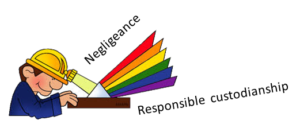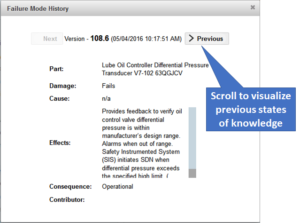Why invest in Living RCM Certified? How would a maintenance organization justify having to build and continuously update an RCM knowledge base? What would be the return on investment of having to reference that knowledge base on each work order? This article proposes one response.
We might frame the question in the context of the corporate mission:
“To be as profitable as possible, to keep operating as long as required, and to comply with the spirit and letter of all regulations intended to keep our employees and the environment safe.”
 The phrase “all regulations” implies that authorities investigating an accident will allocate levels of responsibility. The final report will articulate where the organization lies on a spectrum between negligence and responsible custodianship .
The phrase “all regulations” implies that authorities investigating an accident will allocate levels of responsibility. The final report will articulate where the organization lies on a spectrum between negligence and responsible custodianship .
The investigation will touch all events directly, indirectly, or remotely connected to the incident. Judges, lawyers, politicians, and experts will weigh:
- The state of relevant knowledge in the organization prior to the incident?, and
- The management systems that were in place to monitor, improve, disseminate, and act upon evolving knowledge related to the failure?
The investigation will often reveal that, despite several risk management procedures in place such as RCM, FMECA, HAZOP, and RBA maintenance organizations cannot track their evolving failure management policies as they respond to new facts and experiences that come to light in the course of normal operations. This weak link in physical asset management should be strengthened. For example, work orders should document each instance of a failure mode precisely as it is represented in the RCM knowledge base. Any divergence between RCM knowledge and a technician’s observations should provoke an update to the knowledge base and a corresponding policy update.
 Mesh Living RCM Certified fills these functions thereby shifting management liability towards the right end of the spectrum of responsibility. Mesh can roll back to any previous state of knowledge state to expose errors or omissions that led to a given failure management policy.
Mesh Living RCM Certified fills these functions thereby shifting management liability towards the right end of the spectrum of responsibility. Mesh can roll back to any previous state of knowledge state to expose errors or omissions that led to a given failure management policy.
Finally, if disaster strikes, a manager, standing will at least be able to demonstrate that his organization practices continuous knowledge improvement and policy adjustment based on risk. He can prove that safety critical operational and maintenance policies are analyzed and updated routinely as new facts emerge in the day-to-day work order process.
© 2011 – 2018, Murray Wiseman. All rights reserved.






